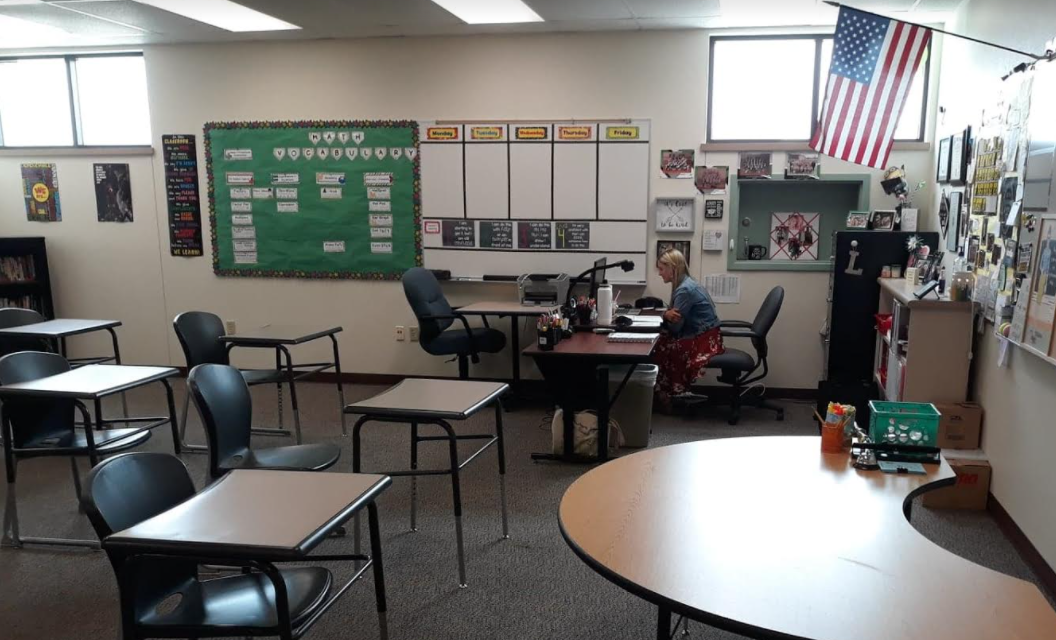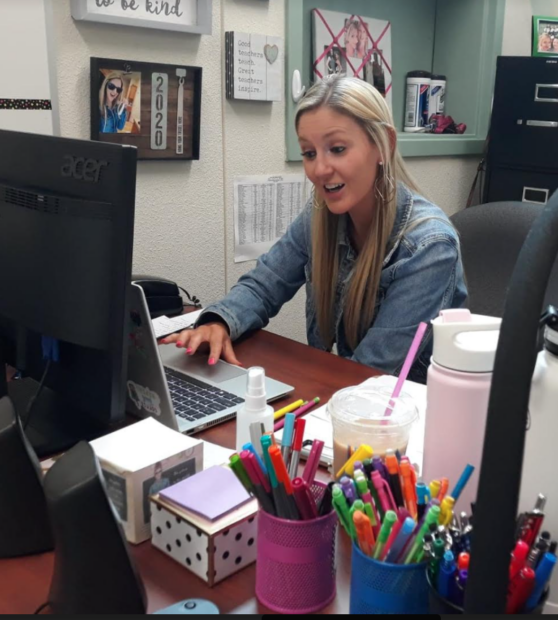This article was written special for IdahoEdNews.org and IdahoPress.com.
NAMPA — Lindsay Hines started the school year teaching in an empty classroom.
As a sixth-grade math teacher at Lone Star Middle School in Nampa, Hines teaches about 130 students across six classes. For her first day of school Monday, she spent her classes sitting at her desk, speaking to her students through a Microsoft Teams meeting.
The Nampa School District decided to start the school year fully online after medical professionals reported that Canyon County was in the highest risk category for the spread of COVID-19. Canyon County is one of the biggest hotspots in Idaho for the pandemic, with 6,798 of the state’s 29,853 total cases.
Lone Star employs about 45 teachers, and administrators gave them the option to work from home instead of in their classroom. Principal Greg Heideman said less than 10 chose to work from home. Most of those who did have young children to care for or health issues that put them at risk, he said.
Hines does not have children, but she does have a minor autoimmune issue that impacts her circulation and her father has a heart ailment. She said she is most concerned about spreading the disease to him, but felt comfortable returning to the classroom with the rest of her students attending online. She said she feels more productive while working in the classroom, and it helps get students in the right headspace to learn.

“It’s probably not going to be perfect, but that’s OK,” Hines said.
The Nampa School District implemented a 1-1 device system before the COVID-19 pandemic hit Idaho, which equipped every student with a learning device that allowed students to attend school from their homes. Hines said each of her students use a Google Chromebook, which teachers also used up until recently, when they were equipped with different computers that had larger screens.
Typically, Hines would teach three classes on Mondays — second, third and fourth period. But for her first day back, she only taught second and third period, as her fourth period accelerated math course won’t begin for a few days. She teaches three different classes on Tuesdays, as Lone Star operates with an A-Day and B-Day schedule.
Despite not having a first period class, Hines still showed up to the building before 7 a.m. to prepare for the day. Her classroom has 14 empty desks spread throughout the room, with the 18 remaining desks that would normally fill the space stacked together in the back, and 19 chairs stacked at the side of the room.

Being the first day of school, Hines didn’t cover any curriculum in her second or third period. Instead, she used the time to introduce herself and try to get to know her students as much as possible.
While outside her classroom in the building, or when interacting with other staff, Hines wore a mask. She took off her mask while she was at her desk. She said she wanted her students to see her face.
In the Teams meeting, Hines was unable to see all her students at once, and some did not have their webcams on for the live meeting. One of her fellow teachers commented that he felt like he was talking to himself during his class.
Hines started each class by taking attendance. She asked each student to mute their microphones until they were called to prevent confusion. Along with marking them present, Hines asked each student a question — what’s your favorite ice cream, or where in the world would you like to visit. Hines’ first class had four students absent out of 31, and five were absent in her second class of 23.
Each period was devoted to short assignments meant to encourage students to share more about themselves and get familiar with the technology they would be using. Hines finished addressing the assignment to each class as a group within about 20 minutes of her 75-minute periods. As the year progresses, Hines said she will likely move to recording herself working through equations on her whiteboard, because she doesn’t enjoy sitting at her desk all day.
Once students finished the day’s assignment, Hines said they could leave the Teams meeting and relax until their next class. For the rest of each period, Hines worked with students individually on challenges they encountered completing the assignment, almost all of which were due to technology issues.
At several points during the day, Hines had to leave the Teams meeting in order to get her internet connection working well enough to send resources to her students. Several other students reported similar problems.
“My internet is running super slow right now,” Hines said, to which one student replied, “Same.”
At least two students had to restart their computers during class because they couldn’t see their assignment. Another group of at least five students reported that they could not see an icon Hines referenced in Teams that would allow students to notify Hines that they had a question without turning on their microphone.
Lone Star has one employee, Drew Williams, devoted to coaching teachers through online learning issues. After third period, Hines contacted Williams about a technical issue she was having in PowerPoint. Williams arrived within 10 minutes and helped Hines through the problem.
Each period is separated by a 15-minute “self-care” period, differing from what Hines said is typically a three to four-minute passing period. These 15 minutes are meant for students to walk around, get a snack or otherwise take a break from the monotony of sitting in one spot all day.
Lone Star’s weekly schedule allows several opportunities for teachers to work with students who might be struggling. Every Wednesday students have the entire day to do what they need to do to catch up on their work, which includes working with teachers or student groups, Hines said. The final period on Tuesdays and Fridays are open periods that teachers can also use to help students.
Nampa School District officials are re-evaluating the spread of COVID-19 cases every two weeks. Heideman said students could return to the classroom as early as Sept. 8 if it is safe enough. Students would likely return in a hybrid model, Heideman said, which would bring a smaller portion of students back to school from day to day.
Hines serves on a team that is working on a plan to transition staff and students into a hybrid model when the district allows it. The plan is not set in stone, but she said teachers must be ready to transition fast. Some teachers, such as herself, have already prepared their classrooms to take students.
While Hines said there are still challenges she has not figured out — such as how to ensure students don’t cheat while taking tests online — she believes she and her students can keep up with online learning through the year.
“And if we need to keep everyone safe, why not?” Hines said.
